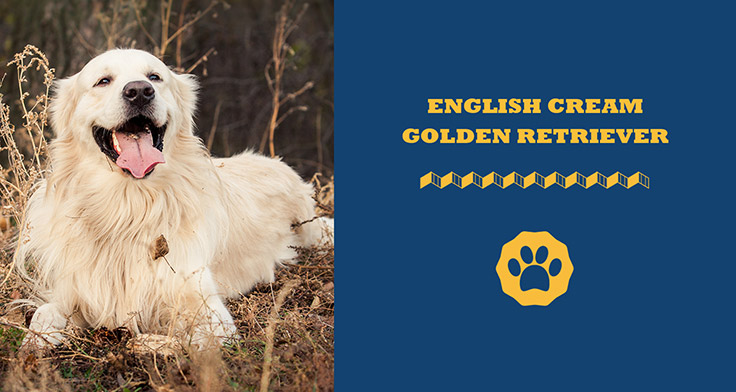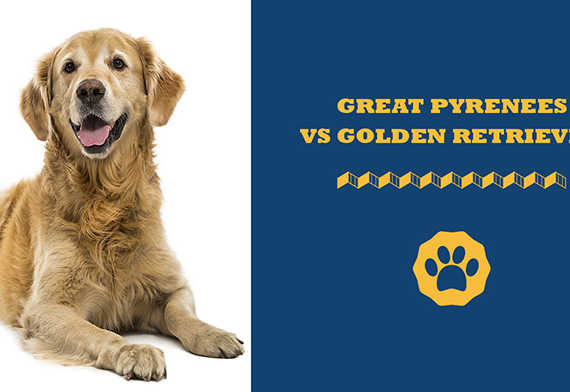Updated: November 11th, 2022
This article contains affiliate links. Read the full disclosure here.

The English cream golden retriever! You’ve probably heard so much about this ‘breed.’ Some say it’s the newest kid on the block. Others claim it’s as rare as gold. What I can’t dispute is that this dog is pleasing to the eye and exactly what you might want as your best friend.
But let’s lay the rumors to rest first. You may have heard some breeders and puppy mills call this dog:
-
- Platinum retriever
- White retriever
- Rare white European golden retriever
- Exquisite platinum imported golden retriever
It’s easy to be overwhelmed by these fancy names, especially if you are interested in buying one from a breeder. But don’t worry, I’ll dissect the answers to all the questions you might have about this ‘breed,’ from its history, size, and appearance to temperament, training, and nutrition, among other topics.
Let’s get started!
The English Golden Retriever Breed History

First things first, the English cream golden retriever isn’t a new or rare breed. In fact, it’s not a separate, unique dog breed at all. No matter what we may call it, it’s still a golden retriever, except that it’s been bred to Fédération Cynological Internationale (FCI) standards, which are different from those of the American Kennel Club (AKC). Put differently, it’s a European import.
It should therefore not come as a surprise that all golden retrievers share the same history. Lord Tweedmouth, a nobleman from Scotland, bred the first golden. This was back in the late 18th century. But it wasn’t until 1911 that Britain’s kennel club recognized it as a breed.
In the following years, breeders imported goldens into the United States. AKC registered them as a breed in 1932, but they changed the breeding standards over the years to suit the tastes and needs of Americans. The European version of this breed took a different direction as well, becoming what some people now call the English cream retriever.
Not too long ago, puppy mills and breeders in the US started importing the European-bred goldens, marketing them as a separate, superior/rare breed because they had a lighter color, among other unique attributes such as stronger front ends.
But as I told you earlier, this is not actually a breed; it’s just another variation of what you know as the golden retriever. Legitimate breeders don’t use any of the alternate names you may have heard, including English cream. To many of us, they are simply golden retrievers.
Size & Appearance
Golden retrievers fall into the medium to a large size class. Not only are they strong but they’re also athletic and endowed with muscular shoulders. Some weigh as little as 55 pounds, but this can go up to as much as 75 pounds depending on gender, among other factors.
Their height ranges from 21 to 24 inches. Those bred in America are the tallest. But their English cream counterparts have broader shoulders and physique. Even though they are slower to mature compared to American goldens, they continue to grow over the years and tend to live longer.
As much as many people refer to them as cream golden retrievers, not all have this color. You will run into a variety of shades, from pale cream to deep gold. But their popularity as English cream goldens is because of the light color, which most Americans seem to be captivated with.
English Golden Retriever Temperament
Goldens are truly man’s best friend. You will hardly find a breed that is as even-tempered and friendly as these cream- and gold-colored beauties. That explains in part why they are loved the world over. Both bloodlines are also sweet, loyal, and very obedient.
European-bred goldens, however, are typically calmer and softer but not as confident as their American counterparts. English cream goldens also like to spend time outside so you have to make sure they have enough space for play and fun. This will be a nice outlet for their pent-up energy.
Fail to do that and the next thing you will be dealing with is destructive behavior. It’s a frustrating experience, but don’t lose sleep over it. Training can work magic on your dog, no matter how bad the behavior is. But only if you do it right.
Ask your vet to refer you to a professional dog trainer if you cannot access one right away. To get you started on this path, we recommend the following products:
Dog Training Collars
Great at improving pet behavior. Options to consider include:
- Herm Sprenger Ultra-Plus Prong Training Dog Collar
- E-Collar Technologies Easy Educator
- Garmin BarkLimiter Deluxe Dog Training Collar
Crates
You can use crates to manage and train your dog. The best ones include:
- Midwest iCrate Double Door Crate
- MidWest Life Stages Folding Metal Dog Crate
- Paws & Pals Double-Door Folding Crate
Anti- Barking Collars
Anti-barking collars help you manage and fix incessant barking in dogs. Here are some options you will not go wrong with:
- SportDOG NoBark SBC-R Rechargeable Bark Control Dog Collar
- PetSafe Spray Shield Animal Deterrent Spray
- Petrainer 998DRB Remote Dog Training Collar
Dog Treats For Training
Treats count as positive reinforcement and are a crucial part of training. The best treats for training include:
- Liver Bits Treats
- The Honest Kitchen Beams Ocean Chews Wolfish Skins
- Bones & Chews All Natural Grain-Free Jerky
Dog Training Courses
Finally, you can also get yourself some training materials to guide you on the basics and even the deeper stuff about correcting destructive behavior. We recommend the following:
Health

English cream retrievers are generally healthy, but like most breeds, are prone to certain conditions. Studies published by the Golden Retriever Club of America and Britain’s Kennel Club show that a huge percentage of golden retrievers die of cancer. But the rate is higher in the US (60%) than in the UK (40%).
From these studies, we can conclude that the cancer risk in European-bred golden retrievers is slightly lower.
Cancer aside, you may have seen claims that light-colored goldens are healthier than their golden-coated counterparts. But this cannot be considered 100% true because there’s no study or report that supports this claim.
That said, there are several other conditions that both the English and American goldens are prone to, namely:
- Hip and elbow/joint dysplasia
- Progressive retinal atrophy
- Bloat
- Heart problems
How Long Do English Golden Retrievers Live (Average Lifespan)?
The lifespan of this breed is partly tied to the conditions they are prone to. European-bred goldens live 12 years on average, while the American ones only live an average of 10-11 years. What this means is that light-colored retrievers often live longer than gold-coated ones.
There may be no solid study that supports this observation, but the statistics don’t lie. Earlier on, we saw that the cancer risk in American-bred goldens is higher. This in part explains why their European counterparts tend to live a few years longer.
But just to be clear, these are findings from studies done on just a sampling of dogs and not all. So, your American or UK-bred retriever may live longer or for a lesser period than the averages, I have mentioned.
All in all, let’s not forget that there are a few actions you could take as a pet parent to help your furry pal live longer, from giving a balanced diet and proper exercise to ensuring they are living comfortably.
Nutrition
The cream golden retriever should be fed a diet that packs in all the essential nutrients. Actually, all the bloodlines under this breed, including the English cream, can eat the same foods. You just have to make sure that the amount is appropriate for their age, activity level, size, and overall health. Check out our complete Golden Retriever Feeding Guide for more information.
It would be a bad idea to take a guess, so if you find yourself unsure about what and how much to feed your cream golden, talk to a vet. Meanwhile, you will be happy to know that the dog food market already has plenty of high-quality kibble, filled with all the required nutrients and specially formulated for this breed.
Some great options I would recommend for your English cream retriever are:
- Taste of the Wild High Prairie Grain-Free Dry Dog Food
- Castor & Pollux ORGANIX Organic Chicken & Sweet Potato Recipe Grain-Free Dry Dog Food
- American Journey Active Life Formula Salmon, Brown Rice & Vegetables Recipe Dry Dog Food
- Wellness CORE Grain-Free Large Breed Chicken & Turkey Recipe Dry Dog Food
- Primal Freeze-Dried Formula Beef
Remember to pay attention to the instructions on the package. Take note of the nutrients present and feeding guidelines so as to avoid overfeeding.
Training
Ever wondered how the name “retriever” came about? I’ll keep it short. Hunters used the first generation of this breed as gundogs because they showed exceptional skills and abilities at retrieving game for them, not only on land but also in the water. This is what earned them the name retrievers.
You can therefore train them as hunting dogs but also as family pets and show dogs. Golden retrievers are well known for their superior intelligence, which is what makes it easy for them to learn and master new tricks, no matter their age. Add to that their heedful nature and you have one of the most easy-to-train dogs.
Fur And Grooming
English creams have a medium-length double coat that is resistant to water. Shedding is moderate for the better part of the year except in the spring and fall when it’s heavier.
Proper care for this coat entails brushing it a couple of times a week so as to minimize tangles and mats. Not forgetting to mention bathing, which is standard care for all breeds. You could do this two or three times a month or more often if your dog gets extremely dirty. Remember to use the right shampoo.
Who Are English Cream Golden Retrievers Best Suited For?
English cream golden retriever puppies and adult dogs make excellent friends with young kids, adult individuals, and even families. They will get along with just about everyone, including other pets.
Just to remind you again, English creams are friendly, fun-loving, gentle, and playful dogs. so even as you enjoy their company, don’t forget to be there for them as well because they too love it when someone is around.
However, be extra careful leaving them alone with small kids, because they are muscular and heavy and therefore more likely to knock them down or cause unintentional injuries during play.
Frequently Asked Questions
Why are English cream goldens so expensive?
Although all golden retrievers are invaluable, the English cream has been touted as a rare/new, special breed that has a lot more to offer than other goldens. None of these claims is true yet these beliefs often raise demand for this dog, making it overpriced.
My advice to you is not to fall for these marketing tricks. On average, English creams sell for between $1500 – $3500, depending on factors such as breeder reputation, your location, and the dog’s lineage, just to name a few.
Are English golden retrievers smarter?
English creams may be different from the other goldens, but they are not smarter than the breed’s other bloodlines. All golden retrievers share the same intelligence level that ranks them fourth out of over 138 breeds.
Can an English golden retriever be white?
The answer is no! As much as some people call them white retrievers, English goldens can never be purely white. The closest you can get is pale cream.
Last Word
Even though their coat is colored differently, the rest of the differences aren’t so significant as to make the English cream goldens better or inferior to their counterparts. They still share so much with the traditional golden retriever and, as I told you earlier, this is the breed they belong to.
Forget about all the fancy names this breed goes by as well. Most are geared toward marketing. You could call them English cream goldens, but let it not be lost on you that this is not a breed but rather a European-bred bloodline.



